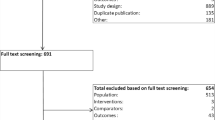Summary
The clinical efficacy and tolerability of simvastatin and fluvastatin were compared in 432 patients with primary hypercholesterolaemia in a multinational, randomised, double-blind trial. Following at least 10 weeks on a lipid-lowering diet, patients continuing to have a total cholesterol level ≥ 6.5 mmol/L and elevated low density lipoprotein (LDL) cholesterol levels received 6 weeks of once-daily treatment with either simvastatin 5mg (n = 109), simvastatin 10mg (n =110), fluvastatin 20mg (n = 105), or fluvastatin 40mg (n = 108). The relative potency rates of simvastatin to fluvastatin in reducing LDL and total cholesterol levels were estimated to be 7.60 and 7.65, respectively. Significantly greater mean reductions in LDL cholesterol levels were found at week 6 with simvastatin 10mg (30%) compared with either fluvastatin 20mg (22%; p < 0.001) or fluvastatin 40mg (26%; p = 0.03). Similarly, LDL cholesterol was lowered more in the simvastatin 5mg group (26%) than in the fluvastatin 20mg group (22%; p = 0.03). No significant difference was seen between simvastatin 5mg and fluvastatin 40mg. Plasma total cholesterol levels were also significantly lower with simvastatin 10mg compared with fluvastatin 20mg (23 vs 16%; p < 0.001) and fluvastatin 40mg (23 vs 19%; p = 0.02), and with simvastatin 5mg compared with fluvastatin 20mg (19 vs 16%; p = 0.01). Simvastatin 5mg and fluvastatin 40mg both lowered total cholesterol levels by 19%. The percentage of patients reaching National Cholesterol Education Program Adult Treatment Panel II (NCEP ATP II) target LDL cholesterol levels after 6 weeks’ treatment with simvastatin 5 or 10 mg/day or fluvastatin 20 or 40 mg/day was 24, 25, 12 and 21%, respectively. Tolerability profiles were generally similar, although significantly more gastrointestinal adverse events occurred in the fluvastatin-treated patients (23 vs 11%). In conclusion, simvastatin 10 mg/day is more effective in lowering total and LDL cholesterol levels than the maximum recommended dose of fluvastatin (40 mg/day), whereas simvastatin 5 mg/day and fluvastatin 40 mg/day showed similar efficacy.
Similar content being viewed by others
References
Anderson KM, Castelli WP, Levy D. Cholesterol and mortality: 30 years of follow-up from the Framingham Study. JAMA 1987; 257: 2176–80
Stamler J, Wentworth D, Neaton JD. Is relationship between serum cholesterol and risk of premature death from coronary heart disease continuous and graded? Findings in 356,222 primary screenees of the Multiple Risk Factor. JAMA 1986; 256: 2823–8
Goldstein JL, Brown MS. The LDL receptor defect in familial hypercholesterolemia. Implications for diagnosis and therapy. Med Clin North Am 1982; 66: 335–62
Holme I. Cholesterol lowering and the reduction of CHD incidence and total mortality: results from a meta-analysis of randomized trials. Cardiovasc Drugs Ther 1992; 6: 101–2
Law MR, Wald NJ, Wu T, et al. Systemic underestimation of association between serum cholesterol concentration and ischaemic heart disease in observational studies: data from the BUPA study. BMJ 1994; 308: 363–6
Gould AL, Roussouw JE, Santanello NC, et al. Cholesterol reduction yields clinical benefit: a new look at old data. Circulation 1995; 91: 2274–82
Blankenborn DH, Azen SP, Kramsch DM, et al. Coronary angiographic changes with lovastatin therapy: the monitored atherosclerosis regression study (MARS). Ann Intern Med 1993; 119: 969–76
MAAS Investigators. Effect of simvastatin on coronary atheroma: the Multicentre Anti-Atheroma Study (MAAS). Lancet 1994; 344: 633–8
The Scandinavian Simvastatin Survival Study Group. Ramdomised trial of cholesterol lowering in 4444 patients with coronary heart disease: the Scandinavian Simvastatin Survival Study (4S). Lancet 1994; 344: 1383–9
Levy RI, Troendle AJ, Fattu JM. A quarter century of drug treatment of dyslipoproteinemia with a focus on the new HMGCoA reductase inhibitor fluvastatin. Circulation 1993; 87 Suppl. 111: 45–53
Friedewald WT, Levy RI, Fredrickson DS. Estimation of the concentration of low-density lipoprotein cholesterol in plasma without use of the preparative ultracentrifuge. Clin Chem 1972; 18: 499–502
Peace KE. Biopharmaceutical Statistics for Drug Development. New York: Marcel Deckker, Inc., 1988: 83–118
Expert Panel Summary of the Second Report of the National Cholesterol Education Program (NCEP) Expert Panel on Detection, Evaluation and Treatment of High Blood Cholesterol in Adults (Adult Treatment Panel II). JAMA 1993; 269: 3015–23
Illingworth DR, Stein EA, Knopp RH, et al. A randomized multicenter trial comparing the efficacy of simvastatin and fluvastatin. J Cardiovasc Pharmacol Ther. In press
Dallongeville J, Fruchart JC, Pfister P, et al. The European Fluvastatin Study Group. Fluvastatin reduces levels of plasma Apo B-containing particles and increases those of LpA-I. Am J Med 1994; 96 Suppl. 6A: 32S–36S
Hagen E, Istad H, Ose L, et al. Fluvastatin efficacy and tolerability in comparison and in contribution with cholestyramine. Eur J Clin Pharmacol 1994; 46: 445–9
European Atherosclerosis Society Study Group: Prevention of coronary heart disease: scientific background and new clinical guidelines. Nutr, Metab Cardiovasc Dis 1992; 2: 113–54
Deslypere JP. Clinical implications of the biopharmaceutical properties of fluvastatin. Am J Cardiol 1994; 73: 12D–17D
Author information
Authors and Affiliations
Additional information
An erratum to this article is available at http://dx.doi.org/10.1007/BF03259374.
Rights and permissions
About this article
Cite this article
Ose, L., Scott, R. & Grossman, L. Double-Blind Comparison of the Efficacy and Tolerability of Simvastatin and Fluvastatin in Patients with Primary Hypercholesterolaemia. Clin. Drug Invest. 10, 127–138 (1995). https://doi.org/10.2165/00044011-199510030-00001
Published:
Issue Date:
DOI: https://doi.org/10.2165/00044011-199510030-00001




